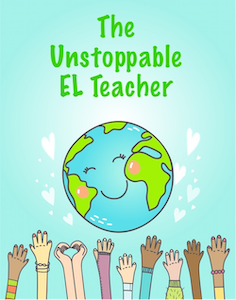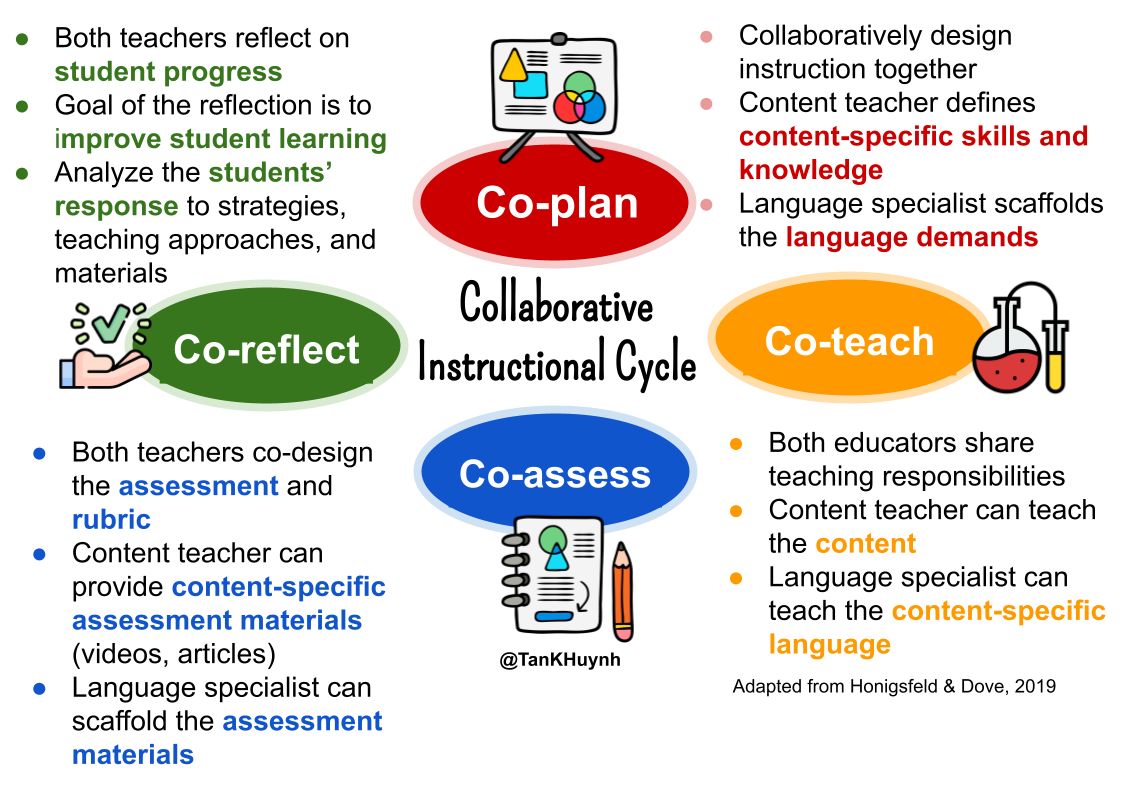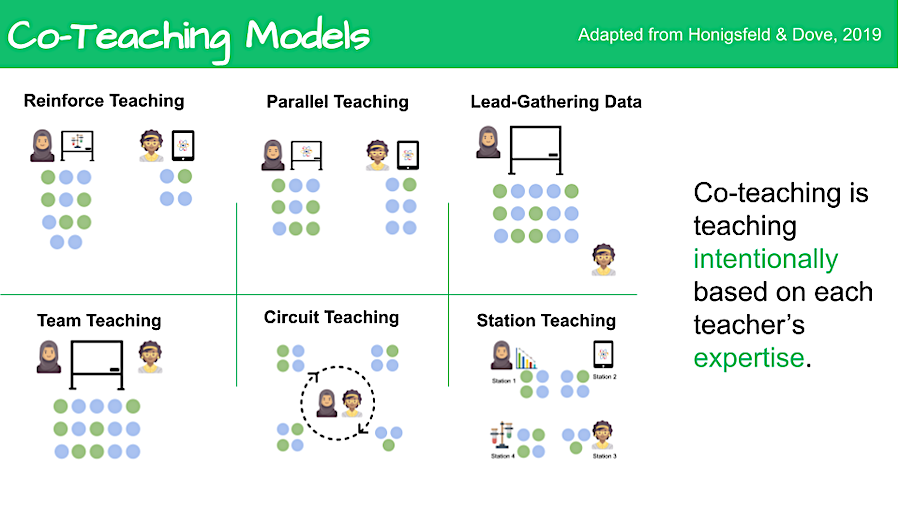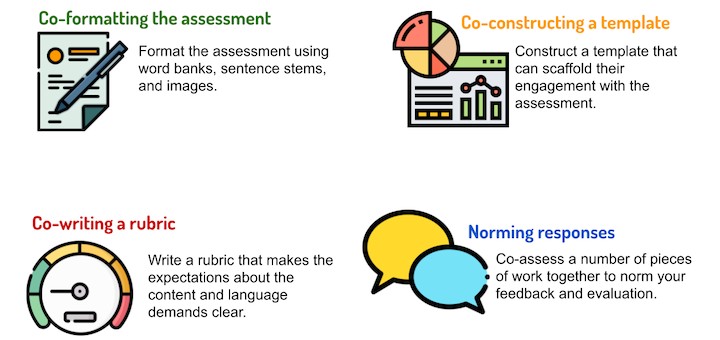Collaborative Instruction Energizes Co-Teaching
A MiddleWeb Blog

Because the role was so new to me, I didn’t realize that there were other components as well, such as co-assessing and co-reflecting.
These components are what Dr. Andrea Honigsfeld and Dr. Maria Dove call the collaborative instructional cycle in their book, Collaborating for English Learners (Honigsfeld & Dove, 2019). If language specialists can incorporate all four of these “co-” components, we can significantly impact our students’ learning.
Let’s take a closer look at each component in this powerful collaborative cycle.
Co-planning
As the collaborative instructional cycle is fluid, you can start at any component. However, since co-planning is so significant, I’ll start there.
Co-planning for language learners means co-designing instruction for students with an eye out for the language required to successfully engage with the content. Co-planning is the foundation of collaborative teaching because it addresses the academic and linguistic needs of language learners.
Co-planning is where language learners stand the greatest chance of receiving scaffolded, sheltered instruction. During co-planning, teachers can:
- write content, language, and cultural objectives
- plan the scope of a unit
- design teaching materials
- select and scaffold resources
- create intentional groupings
- design the structure of the lesson
- plan assessments and long-term projects
- try out strategies
Looking at this list, it’s clear that collaborating this way directly shapes co-teaching. Moreover, co-planning is where equitable teaching practices live.
First, the language specialists act as equal designers of instruction. Co-planning elevates language specialists from being a push-in educational assistant to being the highly competent, revered educator that they are. Second, language learners’ needs are directly addressed and are the focus of the co-planning.
Co-planning happens when we learn to make efficient use of time. I’ve written about my five favorite time-saving co-planning strategies that I use the most frequently in my practice. My top recommendations for teachers during co-planning are to:
• create a consistent co-planning time that lasts at least 30 minutes,
• build on the ideas of your colleagues instead of providing completely new ideas, and
• prioritize co-planning big-ticket items such as assessments and projects.
Co-teaching
Teaching collaboratively means two or more educators in the same room instructing an entire class at the same time. Co-teaching comes in a rainbow of forms, and the roles of the two educators are determined during co-planning and based on the instructional needs of the moment.
Some co-teaching arrangements are:
• both teaching at the same time to the same group of students
• teachers taking different groups to teach the same content in different ways
• one teacher taking a small group to provide extra support or to front load instruction
• one teacher leading instruction as the other floats around to provide support
• students rotating between different stations and meeting both the teachers through the rotations
The services that language specialists provide include such things as:
• teaching the language of the content at the word, sentence, discourse (organization) level (Gottlieb & Ernst-Slavit, 2014)
• teaching how to process content in texts and videos
• modeling writing for a specific task
• front loading content or establishing comprehensible input
• helping students use their home language for social and academic purposes
• modeling a process or protocol
• drawing diagrams while the co-teacher is teaching content
• searching for visuals to project to accompany a lecture
Notice how these actions serve all students, not just students who are identified as language learners. Being a language specialist means that we are experts in teaching academic language, which all students need.
Co-assessing
Formatting assessments
Teachers can collaboratively co-assess students and/or collaboratively analyze student work. When it comes to a final exam test, co-assessing can mean co-designing assessments during co-planning by doing such things as:
• providing sentence starters and frames
• adding word banks and labeled diagrams
• using synonyms for non-assessed words on the test
• breaking down a multi-part question into individual questions
• creating a completely new version of the test for beginners based on the test that everyone else is receiving
The goal of formatting the assessment is to prevent it from becoming a reading test and to keep it focused on assessing mastery of content. Formatting an assessment to support language learners does not water down the rigor. It just makes high achievement possible.
Though I do not personally assess students with my co-teachers, language specialists in the elementary school grades are better placed to help administer tests as they are less content-dependent.
However, both elementary and secondary school language specialists can work with their colleagues to co-create rubrics. Creating well-designed rubrics makes the expectations clearer for students and helps shape daily instruction. Once you’ve created a rubric, it can be the jumping-off point for weekly co-planning meetings.
Analyzing student work
Another component of co-assessing is collaboratively analyzing student work. If teachers are analyzing formative work, analyze how students are using content-specific language.
Are they using specific academic vocabulary? Are they structuring sentences appropriately? Are they organizing ideas according to the expectations (e.g., cause-effect, problem-solution, description, explanations with evidence, etc.).
Co-designing learning experiences
I personally have a third component of co-assessing, which is co-designing learning experiences directly connected to the assessment. There are things that students do formatively to learn the content that will be eventually assessed summatively. They become specific lessons in a unit.
I co-design these learning experiences so that students are successful when formally assessed. Actions that language specialists can do are:
• making texts more accessible to students by text engineering
• designing graphic organizers for students to process and record information
• using technology to make content-specific videos more accessible
• facilitating collaborative learning experiences for students to better process the content
• finding alternative readings or videos for students to learn content (possibly in their home language)
• creating writing templates that will structure their thinking to match that of the assessment
My eyes have only recently been opened in the past few years to the power and effectiveness of co-assessing with my colleagues. Co-assessing is the intersection between co-planning and co-teaching. During co-planning, we need to prioritize co-assessing so that it informs what and how we co-teach. My favorite phrase when co-planning the next unit is:
What do we want students to learn and do by the end of the next unit?
Co-reflecting
Similar to how teachers often ask students to reflect on their work, collaborative colleagues also need to engage in ongoing reflection about their work. The goal of co-reflecting is to improve instruction.
Some topics of co-reflecting include:
• the effectiveness of strategies
• the accessibility of the materials
• the successes and challenges observed
• how effectively the content information was chunked
• students’ ability to independently transfer skills based on the lesson
• how cognitively appropriate the sequencing of content-specific information was
Co-reflecting allows us to regroup and modify instruction to meet students’ needs. My favorite phrase to get my colleague to informally co-reflect with me is What did you notice about… (e.g., What did you notice about the helpfulness of the graphic organizer we created for students?).
This framework invites my colleague to engage in the conversation from observation, not feelings. I often use it after having co-taught a lesson and while students are working on the assignment. I also often start off our co-planning sessions with this question to get us thinking.
Listen to Tan Huynh’s recent podcast conversation with Dr. Maria Dove on teacher collaboration and how school leaders can create a culture of collaboration.
The collaborative cycle builds relationships
My collaborative relationships changed from night to day once I learned about the collaborative instructional cycle. Just like we talk about students using their entire linguistic repertoire, we can fully use all the components of the collaborative instructional cycle when working with colleagues on behalf of language learners. From my perspective, the full use of the cycle has evolved my work with teachers to be more robust and dynamic.
Language specialists often lament that they feel like educational aides despite their expertise. When we fully use the collaborative instructional cycle, we become the empowered, equal, effective designers of instruction we are meant to be.
What component of the collaborative instructional cycle are you most competent in, and which ones will you engage in more?
References
Gottlieb, M. & Ernst-Slavit, G. (2014). Academic language in diverse classrooms: Definitions and contexts. Corwin.
Honigsfeld, A. & Dove, M. G. (2019). Collaborating for English learners: A foundational guide to integrated practices. Corwin.


































This is really helpful! Thank you!
I work in special education and co teach. This is an important framework to use.
I would encourage teachers to also research and intentionally instruct with inclusive practices with co instruction.